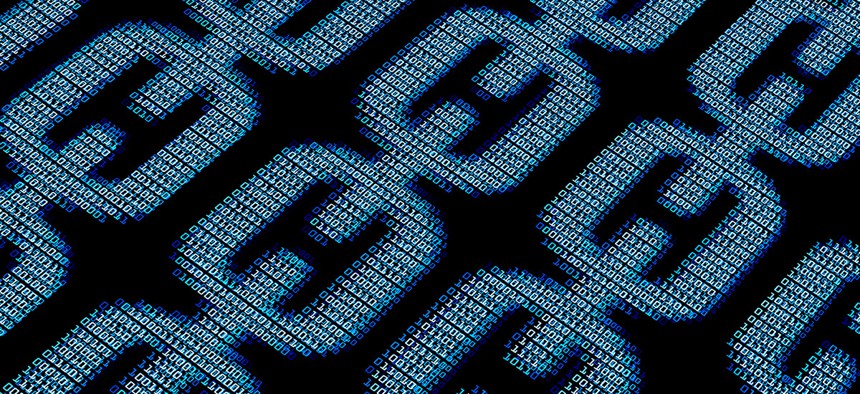Blockchain for Government: A Cheat Sheet

enzozo/Shutterstock.com
The technology could be used for processes that require third-party verification.
Chuck Brooks serves as vice president for government relations and marketing for Sutherland Government Solutions and as chairman of the CompTIA New and Emerging Technologies Committee.
David Logsdon is the senior director of public advocacy for CompTIA.
The General Services Administration recently announced its plans to accept quotes from companies for implementing blockchain and other automated machine-learning technologies to enhance GSA’s Multiple Award Schedules FASt Lane program. The program focus is to speed up the process review time for adding products and services to contract vehicles.
The RFQ states, “GSA seeks to intelligently automate the current MAS FASt Lane contract proposal review processes by utilizing distributed ledger technology, automated machine learning, and/or artificial intelligence based technologies.”
» Get the best federal technology news and ideas delivered right to your inbox. Sign up here.
Also, on July 18, the U.S. Federal Blockchain Forum, a program of GSA’s Emerging Citizen Technology program, organized in partnership with the Secretary of State’s Office of Global Partnerships and GSA’s Office of Information Technology Category, will be hosting a ground-breaking event. The event will:
- Develop, share and discuss practical use cases for blockchain technology among federal government missions.
- Identify resource, policy and compliance needs for the effective and efficient evaluation and implementation of blockchain technology in the federal government.
- Develop a U.S. Federal Blockchain Atlas and road map for the next six months on how agencies can collaborate to achieve our goals and support the creation of shared services for blockchain technology.
What is Blockchain?
In a nutshell, blockchain is a technology and process for managing data and digital assets. It can be characterized as a public decentralized and distributed ledger technology that records historical transactions of any asset or currency. It functions as a peer-to-peer community network via a consensus-driven process. It is the technology behind cryptocurrencies.
Blockchain acts both as the information and the conduit. It also creates an audit trail that makes it appealing for reconciliation purposes of historical records, transactions and regulations that will impact a whole host of future government functions and services.
Most importantly, blockchain can offer government transparency and better efficiency.
A new white paper, “Realizing the Potential of Blockchain,” published by the World Economic Forum provides a good overview of the implications of blockchain for both the public and private sectors. The paper states that “blockchain appears likely to transform a number of important industries that supply or rely upon third-party assurance. It could prove to be a broader force for transparency and integrity in society, including in the fight against bribery and corruption. It could also lead to extensive changes in supply chains and governmental functions.”
The paper further says blockchain’s ability to generate unprecedented opportunities to create and trade value in society will lead to a generational shift from an internet of information to a new-generation internet of value.
The potential public-sector applications of blockchain can be envisioned in the procurement process as exemplified by the GSA RFQ and vendor contracts, but also in the maintenance of health care, employment, deeds, immigration records, Treasury Department transactions, and secure digital voting. It could benefit anything that requires a verification process.
Blockchain can also have utility in optimizing supply chains for the Defense Department and other government agencies. The possibilities for blockchain are numerous and can certainly be of value in navigating and protecting the emerging internet of things as it touches both government and industry.
Blockchain is not solely a federal initiative. Several states (Delaware and Illinois are considering focused pilots) and foreign countries (including Japan and Singapore) are currently exploring adoption. As the experimental pilots and programs move forward, blockchain inevitably will encompass the entire public sector spectrum, including federal agencies, states and foreign governments.
As with any public-sector initiative, blockchain will have to operate under legal protocols and regulations established by both Congress and the executive branch. It will likely have to also rely on the private sector for lessons of best practices and specialized certifications. With the GSA initiative and corresponding events, the timeframe for blockchain coming to government is already on the horizon.





